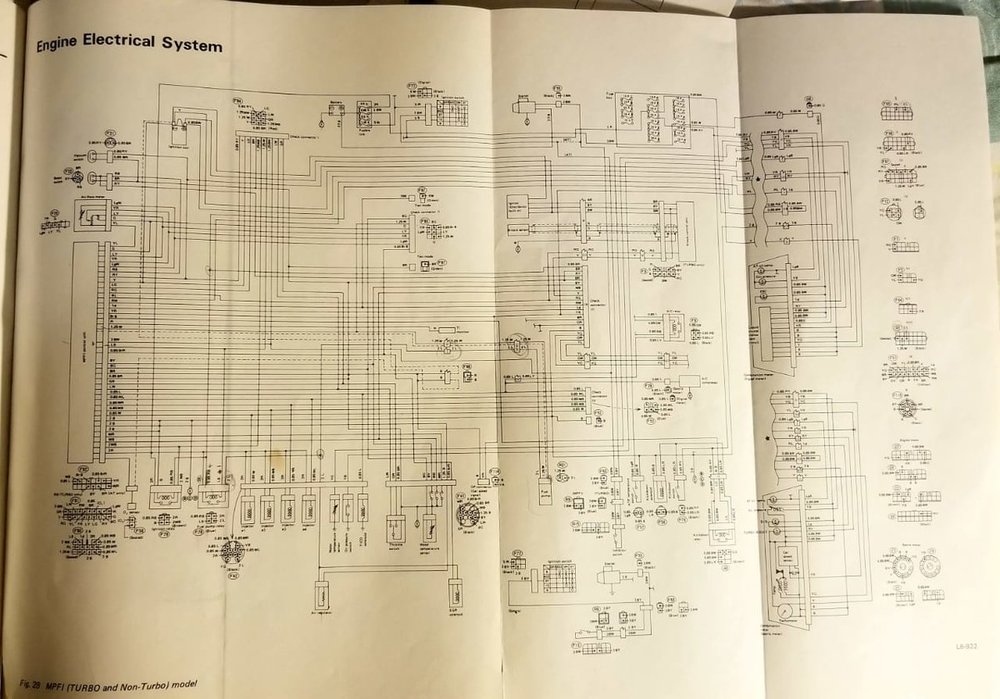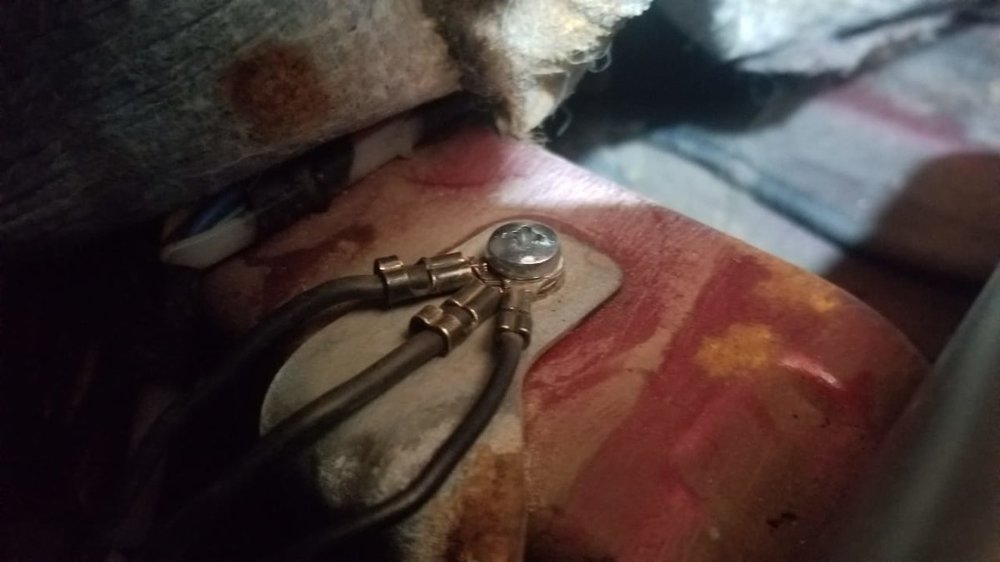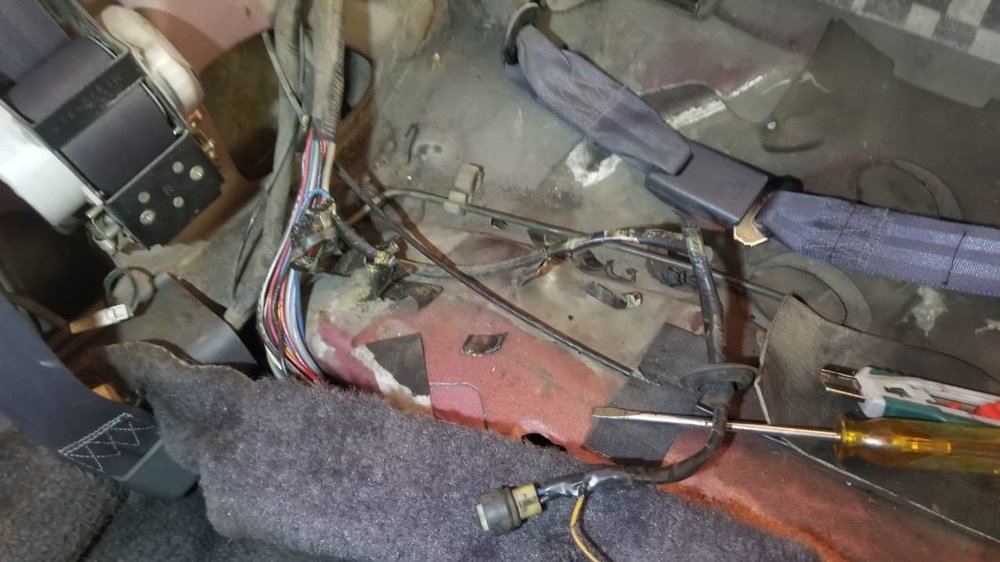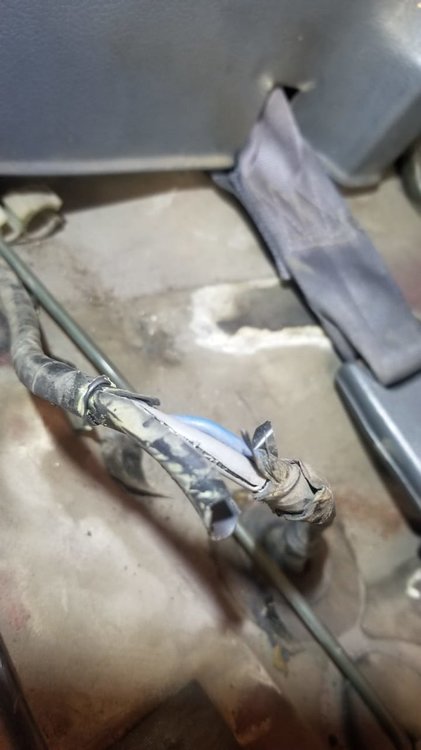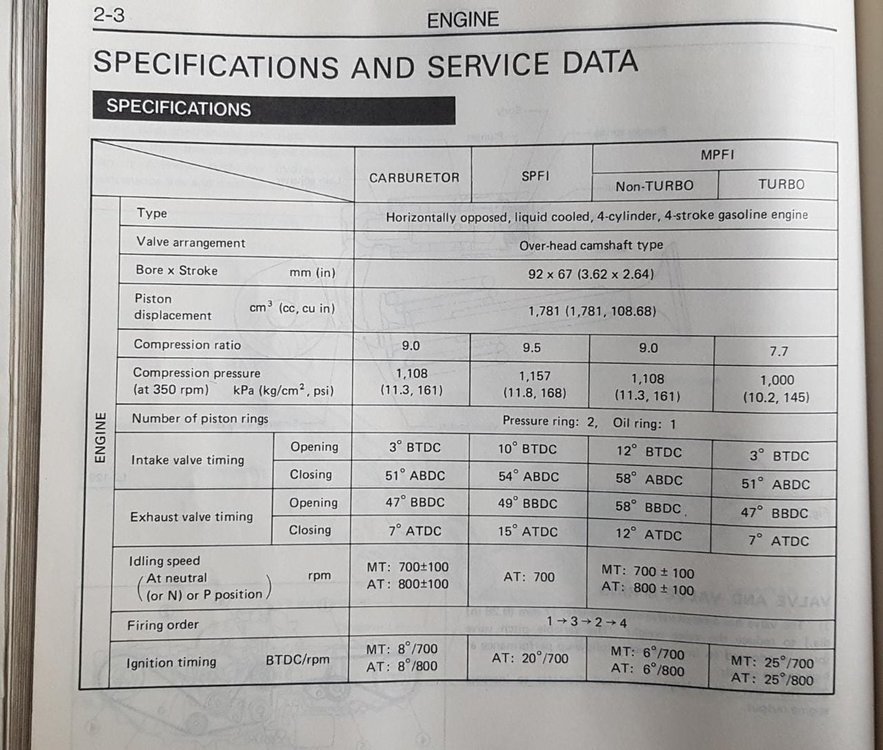-
Posts
115 -
Joined
-
Last visited
-
Days Won
6
Content Type
Profiles
Forums
Gallery
Store
Everything posted by davepak
-
I agree with you @DaveT it looks like this shielded wire's purpose is only as a tiny faraday cage/mesh in case of noise affecting the signal coming from the ECU. I have put everything back together as factory specs. The shielded wire does not touch the negative lead of the fuel pump, it stops maybe 10 cm before that lead.
-
They are indeed. Ive always like them all. But generally, I like coupes, or sport hatchbacks.. so the XT was the best of all among those for me..
-
New development: Well it turns out that my dad's Digital Multi Meter is off. It needs calibration and I didnt realize sbout it, only by chance today when I took a cheap one and by chance compared them.. The cheap one reads 12.36 volts on the battery and the other one 11 point something. Now THIS IS significant because I can infer now that the pump receives its needed 12 volts and most likely the car can operate both radiator fans. Ill go down now and work on this. Additionally, the voltage in the car should be working fine.
-
@idosubaru how many times I have thought of that, but as @el_freddo said, I'd need to swap the heads for that. they come with two openings for the individual injectors. . Oh did I mention that the last injector I haven't replaced is now leaking a bit? No chance to have it changed..this car is reaching its end here I think about getting a BRAT maybe..in a distant future.. I just dont like the wagons, they look too "family and kids" type. Ive always liked the coupes, even the sedans. But they are so hard to find... I had 2 wagons years ago!
-
Definetely is PWM. I can see the fuel pumps change in voltage when revving up the engine, which comes from the ECU that way it can send more fuel when needed, but we are talking a small changes in voltage, however I can see those fluctuations, the shielded mes/shielded wire is intended to absorb and discharge electromagnetic noise, and this is done by the ECU . The reduced voltage at the pump is related to the battery and the alternator struggling to meet the demands of both radiator fans I installed.This car used a fan clutch and an auxiliary fan.. Clearly not intended for 2 fans. Thing is, I couldnt get the fan clutch any more, I actually tried to repair it by injecting thick silicone 5000 into it, it looked like it worked, but it didnt. So I resorted to fit another fan. For practical purposes, I can have it with one fan only and adapt a switch for the second one if needed. When driving, the incoming wind and the higher rpms work together to demand less use of the electric fan. TPS definetely plays a role here. together with the MAF and O2 sensor, all these are working ( I tested them) and the O2 is new.
-
Hard to see, but this is the infamous ECU, and the wiring to the fuel pump. If you can... notice the (- - - - - - - - - - - - - - - - - - -) type of line that signifies the mesh from the shielded wire that goes to the negative lead of the fuel pump together with the actual grounding control wire just next to it.
-
This is an area I haven't worked much on, but I had bought an aftermarket fuel pump and an adjustable pressure regulator, the plan is to fit both of them and see if this solves this hesitation problem. What I've noticed is that the car is working smooth and at some point when hitting the gas it sputters and it "drowns" so I have to stop the car, keep the gas until it picks up again, as if it had a carbbed engine and there was dirt that needed to be passed through.. @idosubaruyou mentioned to check if the vacuum hose was wet.. Meaning "fuel wet" where the pressure regulator might be faulty?
-
My dad reckoned that a problem with the wiring might have been the culprit back then. This car sat for a while while! It has about 100 000 miles..like really? this car did not roll! Most likely the TURBO died and from there all died. Too many sensors giving readings to the ECU, too many no no no, the ECU is overwhelmed. Performance really drops, way to many compensations..nah..really a recipe for disaster..
-
Pressure switch for TURBO and vacuum switch for naturally aspirated.. Why Subaru, why?
-
Ive checked this one out, maybe that knock sensor unit has somehing else to do with the bad performance of this unicorn..
-
Thanks a lot for the words of support! I have realized that the 2 fans I have now for the car are consuming a lot of power, reducing the available power to the fuel pump. At least there was no voltage drop due to anything else
-
Hahaha, I would, but shipping it back to the US?? I don't think is worth it. Oh, that is a custom color, it was Subaru Burgundy when stock, I painted it once in that color, and again in the current color, (hush hush it's a Mazda "purple" color **smirk**)
-
"Today's updates" Alright let's get started... Fine the car actually starts. Upon reasoning on voltage issues, I removed the back seat and traced the wires to and from the fuel pump. There is a special wire that has an internal mesh to it. My dad used to be a tecnician in telecommunications in the late 70s and 80s , so he said: "hey that's a wire that comes with a pulsing signal and the mesh is a protection against noise. The FSM has that wiring and that mesh is meant to come from the ECU together with the grounding signal to the negative lead. They are next to each other. NOW HERE there was something, someone had worked on this part of the car, the shielded-meshed wire had been cut to expose that mesh and the person who did this did not know its purpose, SO, he or she spliced the grounding wire (not the mesh) and took an extra wire to attach it to the chassis as a means of ground. This was ALMOST right in essence, but not at all actually. The fuel pump recives a positive lead from the fuel pump relay, and the negative lead is actuated as a pulse by the ECU as a means of completing the circuit and let the pump run. This is an archaic way of "fuel pump control" So this car HAD some issues with this before. Once this was found, and corrected I tested voltage and operation of the pump and did not notice many changes. However, as per my dad's explanation, the mesh acts as noise reduction due to the electromagnetic "noise" created by the car's various systems, but it is not meant to be a ground to chassis but rather a noise waste discharge controlled via the commanded pulse from the ECU's "permitted grounding/earthing signals." This was a big eureka moment, I tested the wires resistance and all checked out fine, only the attempt by the previous person was mistaken, as he did not know that that mesh was a noise suppresor/protectant, and the negative lead did not have to be touching ground/chassis. So, about the voltage issues. I had mentioned previously that I noticed a voltage drop when the car was at operating temperature, but here the key was: radiator fans kick in! I had removed the faulty-beyond -repair- fan clutch and placed a second fan, now this works together with the AC auxiliary fan. Super. But, power consuming much! When they do come on, the voltage drops badly, from 11.80 v or so down to as low as 9 volts or so to the pump. And from 12.20v to 11.20v or so at the alternator. This is on idlling.. I unplugged one of the fans and the voltage drop was less..So the fans create a high current and voltage demand leaving the alternator struggling. Here something else happens: Im keeping the car in the garage at idle mainly, where it relies a lot on the fans to keep the water cooled, there is no actual running where the wind will help cool the engine, the running will make the alternator generate more power. Odd, isn't it? Too many things working in a recipe for disaster. At one point, with all these findings, the pump was at say 11.60 volts (meh..not that bad right?) and the engine purrs nicely, I know this, I know it has power, torque, all of it, so I tested it and it was true, it is amazing how elegant it sounds, as it has an automatic transmission, it's almost surreal. I decided to take a break, recharge the battery and enjoy a ride on my motorbike. I came back and tested it, yes it sounded great..for a moment, then sputters, a "sudden death" thing where it dies at 2000 a rpm or anything and just boggs all the way down. So what did I do Unicorn?? I moved it in the driveway uphill and .... dead, dead dead. Zero pressure to the pump. Plugged in the jump tester/wire, pump primes and primes...ZERO pressure to the pump. The car is in a nose-up attitude. It wont budge! I switch to neutral, roll the car back, it gets horizontal.. I key it in and it starts like nothing. No what? And I said that aloud too! Im a darn good technician, but this is like detecting a minuscule tumor in a giant body, with no records available and all kinds of possible culprits. I could say that fuel pup operation and voltage fluctuation are due to a slightly discharged battery and the power demands of thw 2 fans on idle. With all this, *I think* I can put it back together and..... sell it for parts? Im doubting it will run propertly, perhaps the tank is badly clogged, perhaps the knock sensor is wrecking havoc with altitude issues, maybe the turbo pressure switch yells at the ECU..maybe maybe.. Pictures: First and second, cleaning a grounding point under the carpet. I thought "hey why not", and "who knows", no changes, just something well done. Third picture shows the fuel pump wires under the back seat, there is a yellow wire spliced-cut into the negative lead coming from the ECU, courtesy of a previous troubleshooter, that same wire has a mesh exposed higher up, courtesy of the same guy, it is here where I tested that mesh connected to that negative lead to the pump, not to chassis. Fourth the last pic shows how that wire was cut to be inspected by that same someone.. Fifth, just a visual explanation of that mess
-
Zero play, and its a new distributor
-
Yeah, I checked them, they are fine, no obstructions, proper ventilation at the fuel separator and the fuel tank's cap too.
-
I'm trying to avoid this route, as checking on what @idosubaru said when he did that, it seems that the ECU might act up even more. I noticed a potential drop in voltage when the car reaches operating temperature, cannot confirm it to a 100%m but 1 h ago this is what happened. There was 11.90 volts to the pump (still not 12v), no whining, 42 psi or so steady, no significant voltage drop at the pump. After a while, voltage dropped to 10.34 volts, the pump was whining in a "wave" with oscillating pressure between 36-42 psi, no significant voltage drop either, but the engine had reached operating temperature and the fans where working. Scratching my head...
-
I find uncanny coincidences very rare and needed to be respected. And then it makes me think that we might be finding something after many years affecting these type of cars. This car has never really worked as far as I've known it. It was abandoned and it "started" but it was barely brought home by a lousy shady mechanic (previous owner) I thought I'd be able to make it work as I had 2 subarus, one carbureted and one SPFi, both were unbreakable. But now, after reading all the FSM, I think about the following systems: Anti Knock System, Turbo pressure switch, anti knock sensor, MAF, coolant thermosensor, the TURBO itself, ECU, etc. They should all work together and despite an old school ECU computer, it worked based on signals, or inputs from potentiometers, enough for binary decisions: more fuel, less air, advance of the spark, retarding it..etc. Perhaps this affected your XT back in the day, I'm leaning on something the ECU is doing to the pump, limiting the voltage supply. (ECU is new certified remanufactured in Canada). This voltage "punishment" is a decision the ECU must be doing on some "unknown" basis to us, highly likely because there is a reading that the ECU is not getting. (or getting) It makes me believe then, that if I was to install a switched relay feeding 12 volts to the pump, ignoring the ECU, I might get the same smoking, shorting issues you had on that 40 miles run.. The ECU could detect the pump's absence and kill the engine's operation altogether. I know this ECU is NOT THAT advanced like modern cars to do that, but it was MORE advanced than the DL's carbureted ECU or even the GL's SPFI one. Say...: Ignition pulse, fuel pump's priming, spark and starting, operating temperature, fuel/air mixture ratio, pressure boost from the TURBO, knoking detection and spark retarding/advancing as needed, atmospheric pressure's influence in the fuel/air mixture and subsequent compensation, reading from the O2 sensor and the coolant thermosensor for more compensations, fuel pressure demands when with load, climbing and at altitutes above 5000 feet (where I live)... I think is a recipe for a terrible engine operation with this car where there is a missing link (or several) in the chain The gearbox is working super smoothly, kick downs, overdrives, D-2-1, reverse, all fine by the way, as I had the chance to ram the gas yesterday
-
Hi @idosubaru ! 1. The voltage never dropped to zero. 2. The voltage started this time at 11.90 volts up to 11.98 volts, no pump whining, pressure at 42 psi. I did a voltage drop test: 0.86 and 0.64 volts in both positive and negative leads of the fuel pump. Also, a super smooth engine's operation and a responsive "driveway" test, it lurched forward nice and strong. 3. There was a drop in voltage and a subsequent change in the pump's operation: the voltage dropped down to 10.34 volts, the pump was in an operational "wave", up and down pressure and whining and less whining, just like a wave, pressure oscillated between 36 to 42 psi. There was no significant voltage drop: 0.34 volts in both leads to the fuel pump. I did not let the car run further, I know after a while the engine's operation diminishes. 4. There is something else here, this change in voltage (drop) seems to happen when the radiator fans turn on, more like, when the engine is warm at operating temperature. AS IF the hotter engine might have something to do with the pump's voltage reception. AS IF the ECU senses a hotter temperature and drops the voltage to the pump? As if that infamous water thermosensor (which is new) is tricking (for no reason) the ECU. (This last part is a total baseless conjecture, more like finding a culprit when I don't know what is causing the problem) I had a suspicion of a voltage drop particularly on the negative (ground) side to the pump. Especially because the ECU uses a grounding signal to operate the pump. However, the voltage drop is not significant and in fact corresponds to less than a volt on each lead.
-
**Updates** calling out at @idosubaru @el_freddo @DaveT @naru2 @john in KY @subaru1988 @Rampage I took the car for a ride. And it did. I can see that all systems work but it all goes down to one thing: FUEL PUMP POWER. The stock fuel pump seems to work better of the three pumps I have. It has a fuel damper and I believe it makes a positive difference on flow and pressure. (It was placed there by Subaru anyhow). But the problem is the actual power that the pumps receives and the subsequent behavior after that. I have seen voltage as low as 8.32 and as fine as 12.03 volts. Why? This suggest a lack of fuel delivery and the car sputtering then dying, this must be the very problem this car has had all along. It fails to deliver the required fuel and when demands increase, it fails to meet them. The pump used to whine a lot, now I have a set pressure out of a pump that is close to the actual requirements (around 40 psi of pressure) and I have noticed a quieter operation. I can only imagine some issues with the wiring feeding the pump. As far as I know, the ECU will supply a ground to actuate the pump "fuel pump ground control". So there must be an issue with this wiring system. But how, why and how can I test it accurately? I am planning to run a live wire with 12v and a chassis ground and see if there is an improvement on the pump's attitude. Any thoughts? The videos show: -The test drive, it reached 3100 RPMs at 40 something miles (I ran out of raod) - Voltage fluctuations at the fuel pump. At one point its around 10 volts, at another around 11 volts even when revved up. It is as if the ECU "forgot" about the fuel pump and it lets it slowly died. I've seen hoe the pressure starts to drop from 40, to 30, 20 psi until the car can no longer run, stalls and dies. VID-20210127-WA0022.mp4 VID-20210127-WA0025.mp4
-
Works continue. But the actual fix does not. The problem has to do with fuel delivery once again. But I can't tell what the problem is. I've seen fluctuation in fuel pressure by the pump's operation, and I wonder whether the ECU is not doing it right. On suspicion of lacking a "ground control" I placed an already spliced ground cable to the chassis to notice a surge of voltage from 8.32 to about 9.40V on idle and subsequently up to 10 plus volts when revved up. But with the addition of the ground cable the pump seems to whine a lot. (like before) The videos show the oscillation on the gauge, like a wave from the fuel pump happening on its own at idle and then the increasing voltage for the fuel pump when hitting the gas pedal.
-
You know.. I just had a moment of realization.. So the FSM indicates that ignition timing is 25 degrees BTDC for a Turbo MPFI AT. But now, my car is NO LONGER turbo. I removed the Turbo, I overhauled the engine with the right pistons to make it a non Turbo Car... An EA82 MPFI Naturally Aspirated. So I'm thinking... Should I then set the timing all the way back to 6 degrees BTDC in this case!!??
-
Ongoing tests. Update @idosubaru @Rampage @el_freddo @1 Grumpy @john in KY So the tests continue. I fitted that aftermarket fuel pressure regulator and with that I have realized that the fuel pump was always whining badly before, regardless of which one ( I have 3 fuel pumps to use) when it had the stock fuel pressure regulator. On setting the pressure at about 39 psi give or take I have noticed that the fuel pump STOPS whining (hey, but not always). And realize this should be the normal operation of it. When the fuel pressure regulator was set at 60 psi or more (I know it was a lot!) it would whine. So my conclusion is that the stock regulator was not working fine. Also, there HAS to be some issues related to fuel delivery as I have noticed the changes with the new regulator set at about those 39psi. As if the car is smooth and steady. Nevertheless, it is not near ready, as when I believe the pressure is fine, I still notice some inconsistencies when ramming the gas pedal. There is some sputtering still. Also, I have checked the fuel lines, they all check with their order: delivery, return, evaporation and vacuum. The fuel filter is like the third in line when the car has rolled less than 500 miles due to this sputtering issues. Additionally, I have seen 2 distinct behaviours regarding the fuel pressure: sometimes the needle on the gauge remains totally solid and even lower than the previously set pressure of 39psi. Other times, the needle oscillates but never going further than say 40 psi, nor lower than 36 psi. This makes me suspect some unexpected issues with the fuel pump's electric circuit.. I recall when placing the aftermarket fuel pump, that if its body would touch ground, I would see a tiny spark, almost like a tiny short circuit, but it wouldn't affect much the pump's operation (or so I think) And given the fact that the wiring has TWO wires for ground, I did not think on grounding the pump's body. So what I think I will do now is work on achieving that sweet spot with the pressure regulator. Set the idle at the infamous 800 rpm for AT and review the ignition timing yet again at those 25 degrees BTDC. This car is like adjusting the Large Hadron Collider!! So many sweet spots at the same time for a lousy 71 odd BHP !
-
That's a very interesting point. It might be possible.. I'll review the fuel lines on the FSM it could be that the return line is acting as the fuel inlet and the fuel inlet as return... I can just swap then and see what happens
-
It is in metric. And it was showing 60psi. Which should be way higher than what the FSM details for the fuel pressure regulator. I lower it at about 40 psi with the adjustment screw. And it seems OK there. However.. Same issues when I drive it. On Park or neutral I rev it up and it goes up fine with minor sputtering. But when engaged in D and launching forward, then it boggs down. RPMs down to 500 and this time it died.
-
You are right @idosubaru these are metric and as pointed out by Bennie, the regulator is set at 60psi give or take. And as per the FSM it should be 36.3 psi. HOWEVER, I had it low at 40 psi and the engine immediately bogged down just about to die. So I wonder what's the deal here, I can say that I heard a bit less of the whining of the pump than before, as if it was restricted so badly by the regulator that the pressure made such a horrible whining noise. I'm heading to the garage and check some of these things now.



